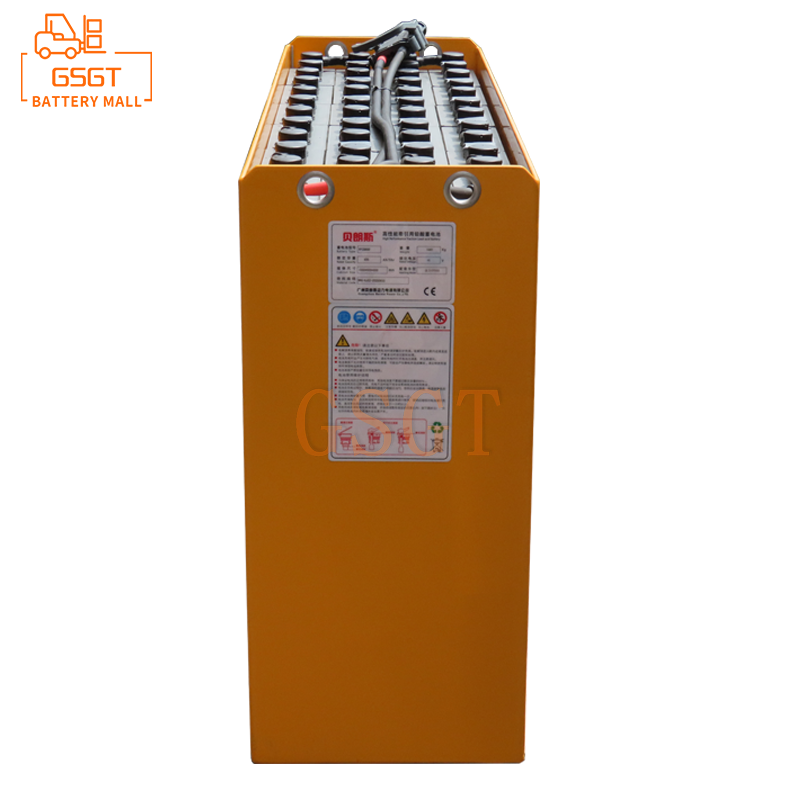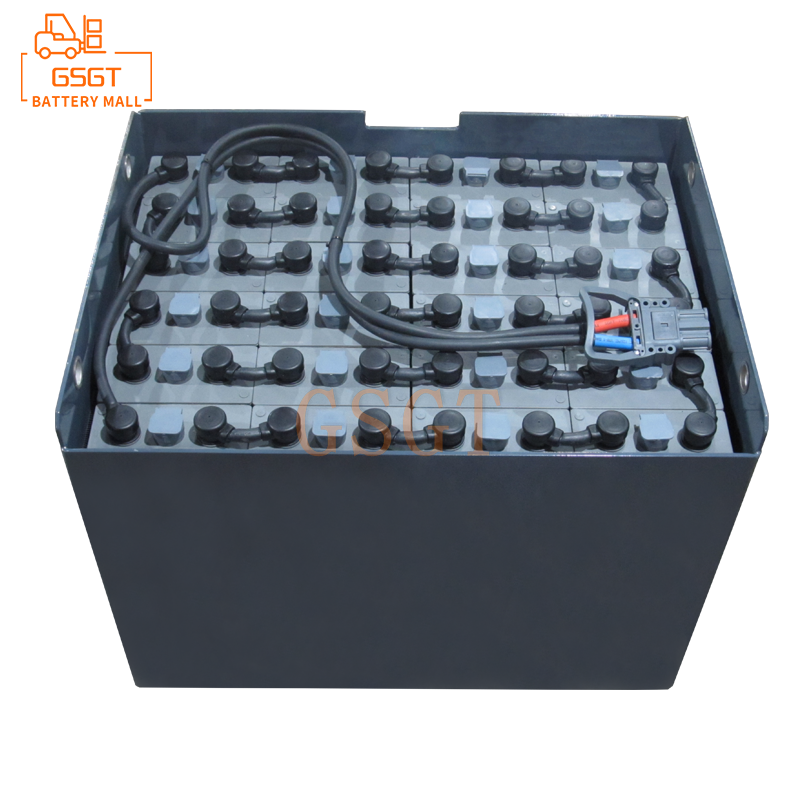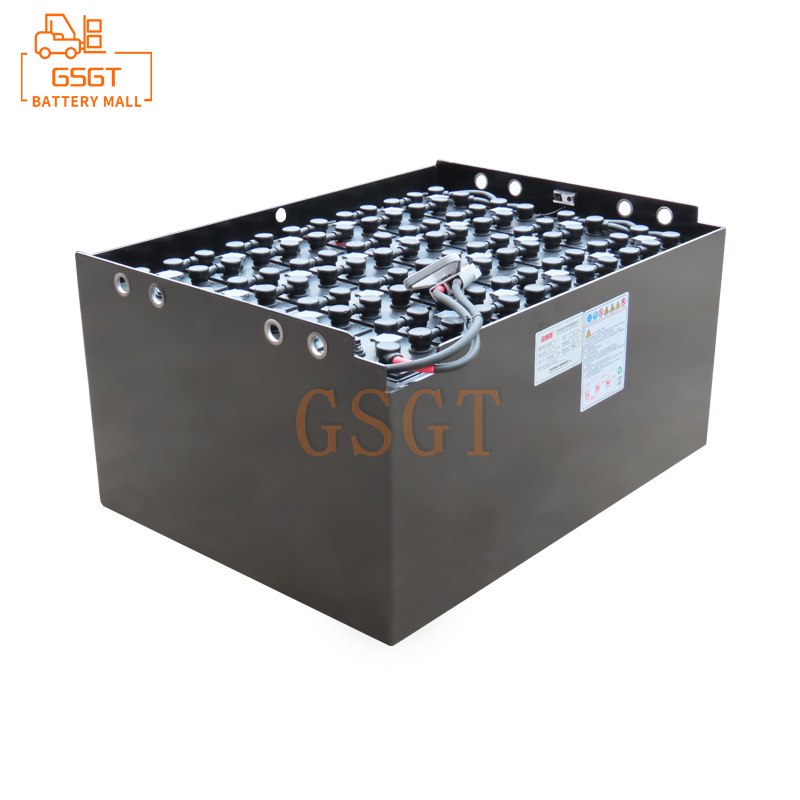Time:2025-07-26 11:42:09
Browse:621
In the operation of forklifts, lead-acid batteries play a crucial role, and their performance directly affects the working efficiency and service life of forklifts. This article will conduct an in-depth analysis of the core performance of lead-acid batteries used in forklifts, helping everyone better understand this key component.
1. Working Principle of Lead-Acid Batteries
Lead-acid batteries are mainly composed of positive plates, negative plates, electrolyte and separators, etc. Electrons flow from the negative terminal to the positive terminal through the external circuit, thereby forming an electric current that provides power for the forklift. The charging process is the reverse process of discharging. Under the action of an external power supply, lead sulfate is respectively reduced to lead dioxide and spongy lead, and the concentration of sulfuric acid in the electrolyte gradually recovers.
2. Core Performance Indicators
(1) Capacity
Capacity is an important indicator for evaluating the performance of lead-acid batteries. It represents the amount of electricity that a battery can discharge under certain conditions, such as a specific discharge rate, temperature, and terminal voltage, and is usually expressed in ampere-hours. For lead-acid batteries used in forklifts, the larger the capacity, the longer the forklift can operate continuously, which can reduce the frequency of charging and improve work efficiency. However, it should be noted that in actual use, the battery capacity can be affected by various factors and may not always reach the rated capacity.
(2) Voltage
The voltage of lead-acid batteries includes electromotive force, open-circuit voltage, working voltage and terminal voltage, etc. The electromotive force of each individual lead-acid battery is approximately 2.04V, and the open-circuit voltage is close to the electromotive force, generally around 2.0V. The working voltage refers to the terminal voltage of a battery when current flows through it during the discharge process, which gradually decreases as the discharge proceeds. When the working voltage drops to a certain specified value, the terminal voltage is reached. At this point, discharge should be stopped; otherwise, it will cause damage to the battery. The nominal voltage and terminal voltage of lead-acid batteries for forklifts of different types and specifications may vary. In practical applications, strict compliance with the requirements is necessary.
(3) Cycle life
Cycle life refers to the number of charge and discharge cycles that a lead-acid battery can undergo under certain charge and discharge conditions. A complete charging and discharging process is called a cycle. The cycle life of lead-acid batteries used in forklifts generally ranges from several hundred to over a thousand times. For instance, the common tubular lead-acid traction battery can have a cycle life of over 750 times under normal usage and maintenance conditions. The longer the cycle life, the longer the battery's service life will be, which can reduce the usage cost. However, frequent deep discharge, overcharging and poor usage environment, etc., will all shorten the cycle life of the battery.
3. Factors Affecting Core Performance
(1) Discharge current
The discharge current has a significant impact on the capacity and lifespan of lead-acid batteries. When the discharge current is large, the capacity of the battery will decrease. This is because when a large current is discharged, the active material on the surface of the plates will rapidly react to form lead sulfate. This lead sulfate may clog the pores of the plates, preventing the active material from fully participating in the reaction. As a result, the internal resistance of the battery increases, the voltage drop accelerates, and the battery reaches the terminal voltage earlier, reducing the amount of electricity that can be discharged. At the same time, high current discharge will also accelerate the corrosion of the plates and shorten the cycle life of the battery. For instance, when forklifts are engaged in high-intensity operations, if high-current discharges are frequently used, the performance and lifespan of the battery will be adversely affected.
(2) Electrolyte temperature
The influence of electrolyte temperature on the performance of lead-acid batteries cannot be ignored either. In a low-temperature environment, the viscosity of the electrolyte increases, and the ion diffusion speed slows down, resulting in an increase in the internal resistance of the battery. Both the capacity and voltage of the battery will decrease, and the start-up and operation of the forklift may become difficult. When the electrolyte temperature is too high (generally exceeding 45℃), although the battery capacity may increase in the short term, it will accelerate the corrosion of the plates and water loss, shortening the battery's cycle life. Therefore, maintaining an appropriate electrolyte temperature (usually around 25℃) is crucial for maintaining the good performance of lead-acid batteries. In practical use, the temperature of the electrolyte can be regulated by installing a battery thermal management system and other means.
(3) Charging method
A reasonable charging method is crucial for extending the lifespan of lead-acid batteries and maintaining their stable performance. Overcharging can cause a large amount of gas to be generated inside the battery, leading to water loss and accelerated corrosion of the plates. Undercharging will cause sulfation of the plates and reduce the battery capacity. Common charging methods include constant current charging, constant voltage charging and pulse charging, etc. For instance, adopting a three-stage charging method, that is, constant current charging first, switching to constant voltage charging when the battery voltage rises to a certain value, and finally performing trickle charging, can effectively enhance the charging efficiency and reduce damage to the battery. In addition, regular equalization charging can make the voltage and capacity of each individual battery in the battery pack tend to be consistent, avoiding the performance of the entire battery pack being affected by the performance differences of individual batteries.
4. Frequently Asked Questions
(1) How to determine whether the lead-acid battery used in a forklift needs to be replaced?
When the following situations occur, it may be necessary to consider replacing the battery: First, the battery capacity drops significantly, such as the working time of the forklift being greatly shortened, and even when fully charged, it still cannot meet the normal operation requirements; Second, the cycle life of the battery has approached or reached its nominal value, and its performance has severely declined. The third is that the battery shows physical damage such as leakage and bulging. Fourth, the battery gets extremely hot during charging, or the voltage fails to reach the normal range after charging.
(2) Why is it necessary to add water to lead-acid batteries regularly during their use?
During the charging process of lead-acid batteries, water is electrolyzed to produce hydrogen and oxygen which escape, causing the moisture content in the electrolyte to gradually decrease. If water is not replenished in time, the concentration of the electrolyte will be too high, accelerating the sulfation and corrosion of the plates, and reducing the battery capacity and lifespan. Therefore, it is necessary to regularly check the electrolyte level and add distilled water or dedicated supplementary liquid to maintain the normal level and concentration of the electrolyte. However, it should be noted that when adding water, it should be done after the battery is fully charged, and too much should not be added to avoid overflow, which may cause corrosion and safety hazards.
(3) How is the recycling and utilization of lead-acid batteries used in forklifts?
Lead-acid batteries are one of the batteries with relatively high recycling rates at present. Their main components, such as lead and sulfuric acid, all have high recycling value. More than 99% of lead-acid batteries can be recycled. The recycled lead can be reused to make new battery plates, and other components such as sulfuric acid can also be processed and reused. Through effective recycling and reuse, not only can resource waste be reduced, but also environmental pollution can be lowered, which meets the requirements of sustainable development. At present, there is a complete lead-acid battery recycling system, including formal recycling enterprises and recycling processes, to ensure that used batteries are properly disposed of.
In conclusion, the core performance of lead-acid batteries used in forklifts is directly related to the operating conditions of forklifts. Understanding their working principles, performance indicators and influencing factors, as well as mastering the solutions to common problems, is of great significance for the rational use and maintenance of lead-acid batteries, improving the working efficiency of forklifts and reducing operating costs. In practical applications, the appropriate lead-acid battery should be selected based on the working environment and requirements of the forklift, and it should be used and maintained strictly in accordance with the operating procedures to fully leverage its performance advantages and extend its service life.

$3810

$3070

$5710

$7660

MESSAGE
Professional And Efficient
Security
Affordable Price
Professional Services